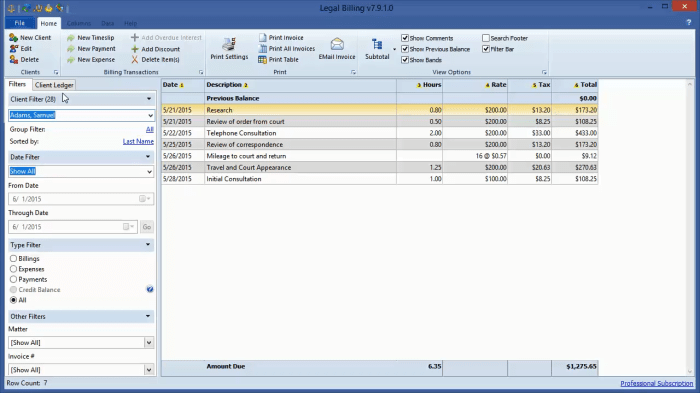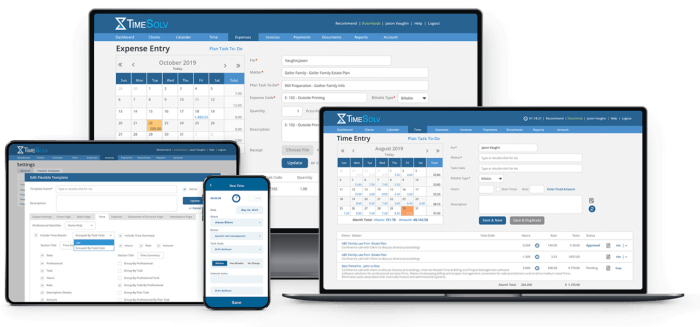Simple legal billing software offers a transformative solution for legal professionals seeking efficient and accurate billing processes. This software streamlines administrative tasks, allowing lawyers and their staff to focus on what truly matters: client representation and legal strategy. From time tracking and invoice generation to client communication and reporting, these systems provide a comprehensive suite of tools designed to enhance productivity and profitability within the legal field.
The advantages extend beyond mere efficiency, offering improved client relations through clear and timely billing, and ultimately, contributing to a more streamlined and successful legal practice.
By automating repetitive tasks, simple legal billing software frees up valuable time and resources. Features like customizable invoice templates, automated reminders, and integrated payment processing reduce administrative overhead, minimizing the risk of errors and delays. Furthermore, many systems offer robust reporting capabilities, providing valuable insights into billing trends and financial performance, enabling informed decision-making for long-term growth and financial stability.
In the dynamic landscape of legal practice, efficient billing is paramount. It directly impacts profitability, client relationships, and overall firm management. While complex legal billing systems offer a multitude of features, many smaller firms or solo practitioners find themselves overwhelmed by their complexity. This is where simple legal billing software steps in, offering a streamlined and user-friendly solution to manage invoices, track time, and improve financial oversight.

Source: cofes.com
This comprehensive guide explores the benefits, features, and considerations of choosing the right simple legal billing software for your practice.
Understanding the Need for Simple Legal Billing Software
The traditional methods of legal billing – spreadsheets, handwritten notes, and manual calculations – are time-consuming, prone to errors, and ultimately inefficient. Simple legal billing software addresses these shortcomings by automating key processes, improving accuracy, and providing valuable insights into your firm’s financial performance. This allows lawyers to focus on what they do best: practicing law.
Key Benefits of Simple Legal Billing Software:
- Time Tracking Automation: Accurately track billable hours with ease, eliminating the need for manual time sheets and reducing the risk of missed charges.
- Automated Invoicing: Generate professional, customized invoices quickly and efficiently, reducing administrative burden and improving cash flow.
- Expense Tracking: Easily record and categorize expenses related to specific cases or clients, providing a complete financial picture.
- Improved Client Communication: Streamline communication with clients regarding invoices and payments through online portals or email integration.
- Enhanced Reporting and Analytics: Gain valuable insights into your firm’s financial performance through detailed reports and dashboards, allowing for data-driven decision-making.
- Reduced Administrative Overhead: Automate repetitive tasks, freeing up valuable time for more profitable activities.
- Improved Accuracy: Minimize billing errors and ensure accurate client billing.
Essential Features to Look For in Simple Legal Billing Software
While simplicity is key, effective legal billing software should still offer a range of crucial features. When selecting a system, consider the following:
Core Features:
- Intuitive Interface: The software should be easy to navigate and use, even for those with limited technical expertise. Look for a clean, user-friendly design.
- Time Tracking Capabilities: This should include features such as timers, manual entry, and the ability to categorize time entries by client, matter, and activity.
- Invoice Generation: The software should allow for the creation of professional invoices with customizable templates, including client information, case details, and payment terms.
- Payment Processing Integration: Integration with online payment gateways (e.g., PayPal, Stripe) simplifies the payment process for both you and your clients.
- Reporting and Analytics: Essential for tracking key performance indicators (KPIs), such as billable hours, revenue, and expenses. Look for customizable reports and dashboards.
- Client Management: The ability to store and manage client information, including contact details, case history, and payment information.
- Matter Management: Organize and track cases efficiently, linking them to associated time entries, expenses, and invoices.
- Security and Data Backup: Ensure the software provider offers robust security measures to protect sensitive client data and provides regular data backups.
Advanced Features (Optional):, Simple legal billing software
- Trust Accounting Integration: For firms handling client funds, integration with trust accounting software is crucial.
- Document Management: Integration with cloud storage services or document management systems can streamline document organization and access.
- Legal Specific Codes and Terminology: Some software caters specifically to legal terminology and billing codes, simplifying the process.
- Mobile Accessibility: The ability to access and use the software from mobile devices enhances flexibility and productivity.
- API Integrations: For greater customization and workflow integration with other software.
Choosing the Right Simple Legal Billing Software: Key Considerations
Selecting the appropriate software depends on your firm’s size, specific needs, and budget. Consider the following factors:
- Scalability: Choose software that can grow with your firm, accommodating increasing caseloads and user needs.
- Pricing and Subscription Models: Compare pricing plans and subscription models to find a solution that fits your budget.
- Customer Support: Reliable customer support is crucial, particularly when encountering technical issues or needing assistance with the software.
- Ease of Use and Training: The software should be intuitive and easy to learn, with readily available training resources.
- Security and Compliance: Ensure the software meets relevant data security and compliance standards.
- Integration with Existing Systems: Check for compatibility with your current practice management software or other tools.
Frequently Asked Questions (FAQs)
- Q: What is the difference between simple and complex legal billing software?
A: Simple legal billing software focuses on core billing functions with a user-friendly interface, suitable for smaller firms. Complex systems offer more advanced features but can be more expensive and challenging to learn. - Q: How much does simple legal billing software cost?
A: Pricing varies widely depending on features, user numbers, and subscription models. Expect monthly or annual fees ranging from a few dollars to several hundred dollars per user. - Q: Can simple legal billing software handle trust accounting?
A: Some simple legal billing software integrates with trust accounting solutions, while others do not. Check the features before selecting a system. - Q: Is simple legal billing software secure?
A: Reputable providers prioritize data security through encryption, access controls, and regular backups. Always check the provider’s security measures. - Q: What if I need help with the software?
A: Most providers offer customer support through phone, email, or online resources. Look for providers with responsive and helpful support teams.
Resources
- American Bar Association (General legal resources)
- Law.com (Legal news and information)
Conclusion
Implementing simple legal billing software can significantly enhance the efficiency and profitability of your legal practice. By automating time-consuming tasks, improving accuracy, and providing valuable insights, these tools empower lawyers to focus on their core competencies. Carefully consider your firm’s specific needs and choose a system that offers the right balance of simplicity, functionality, and security. Investing in the right software is an investment in the future success of your practice.

Source: chaossoftware.com
Call to Action
Ready to streamline your billing process and improve your firm’s efficiency? Explore the various simple legal billing software options available today and find the perfect fit for your practice. Start your free trial or request a demo now!
In conclusion, embracing simple legal billing software represents a strategic move towards a more efficient and profitable legal practice. By automating billing processes, enhancing client communication, and providing valuable data-driven insights, these systems empower legal professionals to optimize their workflows and focus on delivering exceptional legal services. The ultimate benefit is a more streamlined and successful legal practice, built on a foundation of accurate billing, efficient administration, and satisfied clients.
Answers to Common Questions
What are the key features of simple legal billing software?
Key features typically include time tracking, invoice generation, expense tracking, client management, reporting, and payment processing.
How much does simple legal billing software cost?
Pricing varies widely depending on features, scalability, and vendor. Expect a range from affordable monthly subscriptions to more substantial costs for enterprise-level solutions.
Is simple legal billing software secure?

Source: timesolv.com
Reputable providers prioritize data security with features like encryption, secure backups, and compliance with relevant regulations. It’s crucial to research a vendor’s security protocols before committing.
Can simple legal billing software integrate with other legal software?
Many solutions offer integrations with other legal tech tools, such as case management systems and document management platforms, to streamline workflows further.
What kind of training is needed to use simple legal billing software?
Most software is user-friendly and offers tutorials, documentation, and often customer support to ease the transition. Training needs vary depending on the complexity of the software and user experience.